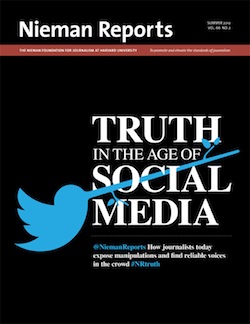Editor’s Note: Our colleagues upstairs at Nieman Reports are out with their Summer 2012 issue, “Truth in the Age of Social Media,” which focuses on issues like verification, crowdsourcing, and citizen journalism. Over the next few days, we’ll give you a glimpse at some of their stories — but make sure to read the issue in full. In this piece, The New York Times’ Linda Greenhouse challenges the old credo that a newspaper must “report all sides of a controversial issue” and leave it to the reader to find truth.
 A 2009 story in The New York Times about a dispute involving Fox News described the cable network as “a channel with a reputation for having a conservative point of view in much of its programming.”
A 2009 story in The New York Times about a dispute involving Fox News described the cable network as “a channel with a reputation for having a conservative point of view in much of its programming.”
Really?
That phrase “with a reputation” put the reporter, and the newspaper, at arm’s length from the fact that the Fox News Channel does have a conservative point of view, and proudly so.
What was the purpose of that distancing phrase?
A 2011 New York Times article, typical of many others, referred to Jared Loughner as “the man accused of opening fire outside a Tucson supermarket.” Whether the Tucson shooter is guilty of murder is a legal question, but there is no question at all about his identity as the man who shot Congresswoman Gabrielle Giffords and killed six people. We don’t have to say “accused of” — he did the deed in front of dozens of witnesses.
I’m not picking on the Times — the newspaper I read most carefully as well as the place I worked for 40 years. And although it is attacked, most often from the right but not infrequently from the left, for various kinds of bias, it actually, in both its performance and its ideals, epitomizes the commitment of mainstream journalism to the goals of fairness and objectivity.
This is nothing new. Adolph Ochs, the founding publisher of the modern New York Times, whose byword was “without fear or favor,” believed that a responsible newspaper should “report all sides of a controversial issue, and let the reader decide the truth,” according to a reminiscence written a couple of years ago for internal distribution to the Times staff.
In this article, I will raise some questions about the assumption behind that credo, as well as the utility, in this media-saturated and cynical age, of the siren call of “fairness and objectivity.”